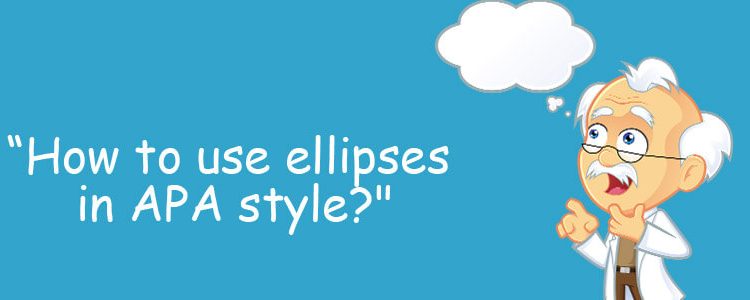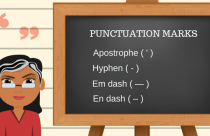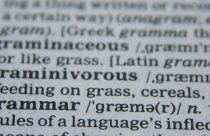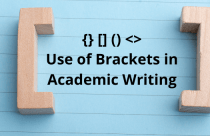How to Use Ellipses in APA Style

An ellipsis is a series of three periods (also called “ellipsis points” or “ellipsis dots”) that are used to replace missing or purposely omitted text. In most cases, an ellipsis is used within quotations, but it is also used in conversations to indicate a pause or unfinished thought, as in the following example:
I’m going to the store to get . . . oh, I don’t remember.
There are rules for inserting ellipses into text depending on the style guide used. The American Psychological Association (APA) and Chicago Manual of Style (CMOS) have similar styles for formatting ellipses. The Modern Language Association (MLA) suggests surrounding an ellipsis with brackets. Here, we discuss the APA protocols for writers when using an ellipsis.
The Basics
The following are the basic guidelines for using an ellipsis in the APA format.
- Use three periods with space before and after each (e.g., “ . . . ”).
- Do not use brackets around your ellipsis.
- Use four periods for omitted text at the end of a sentence, with no space before the first period that indicates the end of the sentence (e.g., “End of previous sentence. . . . Next sentence.”).
- Do not use an ellipsis at the beginning or end of a quoted passage unless necessary for clarity.
- An ellipsis should be considered a “unit” of punctuation; therefore, the three (or four) periods must always be kept together.
- A period follows the sentence that precedes an ellipsis at the beginning of the next line.
- Four is the maximum number of spaced periods in an ellipsis.
There are some pitfalls to watch out for when using ellipses. Using them too often in your text might be cumbersome to the reader; therefore, insert them sparingly and when necessary. Use an m-dash (—) instead for interrupted dialogue.
Related: Are punctuation marks leaving a question mark on your face?? Check out some useful resources now!
Caution
Exercise caution when using ellipses and omitting text. Be sure to check your text carefully to avoid any of the following issues.
- When writing for any discipline that uses the APA style, do not use the automatic ellipsis codes. These will not insert a space between the periods. For example, the Unicode 2026, which sometimes suggests inserting an ellipsis, appears without spaces (“…”). If using APA style, this would be incorrect and would need to be replaced with three spaced periods.
- Make sure that when you omit text, you do not change the meaning of the sentence, especially when omitting words or phrases in quoted text.
- Make sure that you do not create grammatical errors by omitting text.
Quotes and Ellipses
As mentioned, ellipses are most often used to signify omitted text in quotations, but they need not be used when simply using a quotation mid-sentence. For example:
Original sentence: “Stars have disproportionately high and prolonged performance, visibility, and relevant social capital, and there are minimum thresholds for each that must be attained to be a star.”
Quotation used in text: One theory of exceptional employee behavior posits that star employees “have disproportionately high and prolonged performance, visibility, and relevant social capital” (Call, Nyberg, & Thatcher, 2015, p. 630).
Note how the authors of the piece in which the quoted material was used have written the text in a way such that no ellipsis is necessary for the omitted text. It would be incorrect to do the following:
One theory of exceptional employee behavior posits that star employees “. . . have disproportionately high and prolonged performance, visibility, and relevant social capital. . .” (Call, Nyberg, & Thatcher, 2015, p. 630).
In this case, the omitted text was not important to the message and was deleted; the remaining text was surrounded by double quotation marks; no ellipsis was necessary.
What about quotations that comprise more than one sentence? What would be the correct punctuation of each subsequent sentence (i.e., capitalize the first word)?
Consider the following quotation:
“Beyond competitive pay and deep networks, stars—more than others—may be motivated to remain with organizations that provide opportunities to influence others or be involved in strategic decision-making. For example, a star union leader who is trusted to negotiate on behalf of membership may be motivated by nonfinancial opportunities, such as the chance to be seen as a leader, and hence, appealing to self-enhancement and self-expansion motives as described earlier. Thus, providing such influence opportunities may help organizations retain stars more than they help retain other employees.”
Again, we would use four ellipsis periods at the end of one sentence and before the beginning of the next sentence. The following excerpt shows how the writer interpreted the above quotation and how he or she joined the sentences using an ellipsis:
Call et al. (2015) theorized that star employees “may be motivated to remain with organizations that provide opportunities to influence others or be involved in strategic decision-making. . . . providing such influence opportunities may help organizations retain stars more than they help retain other employees” (p. 633).
Note the four ellipsis points after “decision-making” signifies the end of the sentence. The first word in second quoted sentence is not capitalized and that quotation marks are used around the entire passage.
Other Punctuations
When using other punctuations with ellipses, such as commas, colons, and semicolons, their placement depends on where the omitted text is replaced by an ellipsis. If the ellipsis comes before the punctuation, the punctuation follows it with no breaking spaces (e.g., “ . . . ;”). If the ellipsis follows the punctuation, the punctuation precedes it (e.g., “ , . . .”). Note the spacing in each example. It is important to recognize the different protocols among different style guides. Be sure to follow the appropriate format designated in the style guide for your discipline during manuscript formatting.
References
Chelsea Lee (2015, May 27) Punctuation Junction: Quotation Marks and Ellipses. Retrieved from http://blog.apastyle.org/apastyle/2015/05/punctuation-junction-quotation-marks-and-ellipses.html









